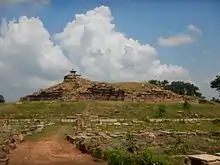Beejamandal
Beejamandal is a ruined temple in Jatkara village[1][2] near Khajuraho, that has not yet been fully excavated [3] and explored.[4] It has a length of 34.60 meters and is thus longer than the largest temple of Khajuraho namely Kandariya which measures about 30 metres.[5]

Beejamandal which is popularly known as vijaya temple is situated about 2 kms from Eidgah square on vidisha-ashoknagar road. It is rich in archaeologically interesting objects. It is said that the building was built in 8th century then later on reconstructed in Paramara period in the second half of 11th century by Emperor Naravarman and since he was a devotee of Goddess Charchika who is also known as Vijaya because of which it is popularly known as Vijaya temple. Though the building was never finished which can easily be seen by the carved niches and unfinished architectural pieces found round the base of the temple plinth. During mughal emperor Aurangzeb period (1658A.D.-1707 A.D.) the temple was demolished by him and he made a mosque over the demolished remains of the temple and named it as "Alamgir Mosque" (around 1682 ).Muslims started worshiping the mosque after the construction of mosque for many years.
Then later on in 1991 there was a heavy rain in the night in the town ,the rain was so heavy that one of the wall of the mosque fell down due to which so many Hindu idols were exposed which were inside it for more than 300 years and brought the public attention that this is a Hindu temple since there were so many Indian idols were found inside the temple after one of the wall fell down. Then later on Archaeological survey of India (ASI) did the investigation to find out the truth and by the research they got to know that these Hindu idols were buried under the platform on the northern side which was used as the Hall of Prayer conducted especially on the days of Eid. Also figures of Goddess Mahishasur Mardini and lord Ganesha were recovered during the excavation in (1972-1974).But unfortunately a stay was put on the officer of archaeological survey of India, who was conducting the research and also the collector of that time of the town was transferred as under his orders only the entire investigation was happening. The stay was applied by the government to avoid any riots between Hindu and Muslims.The case is still in the court but to maintain peace and Harmony this case is under status quo. [6]
'Beejamandal' at Khajuraho is near the Chaturbhuj temple. It was opened to visitors in 1999[7]
In all there are supposed to be 85 temples in Khajuraho, however only 22 of them have been unearthed. Beejamandal is one of the many which are yet to be discovered. According to the local villagers this structure was under a huge mound of earth which was marked on the apex by a white stone. The villagers regularly lit the holy oil-lamp each night on this mound since time immemorial.
Cunningham [8] and Phanikanta Mishra[9] regard this as the Vaidyanath temple mentioned in the Grahapati Kokkala inscription.
It was one of the 18 unexplored mounds he vicinity of Khajuraho.[10] The archaeological survey of India does not have the authority to excavate other mounds.
See also
References
| Wikimedia Commons has media related to Beejamandal. |
- खजुराहो के पास खुदाई में भव्य शिव मंदिर के अवशेष मिले, 20 July 2003,नवभारत टाइम्स, http://navbharattimes.indiatimes.com/articleshow/53081588.cms
- Cunningham, Alexander (1880). Report of Tours in Bundelkhand and Malwa in 1874-75 and 1876-77. 8 Hastings Street, Calcutta: Office of the Superintendent of Government Printing. p. 22. Retrieved 8 May 2017.CS1 maint: location (link)
- Hidden secrets of Khajuraho, Atul Sethi, Times Of India, 14 April 2007, http://articles.timesofindia.indiatimes.com/2007-04-14/special-report/27884442_1_khajuraho-temples-mounds
- NEW TEMPLES UNEARTHED AT KHAJURAHO http://pib.nic.in/feature/fe0899/f1908991.html
- Purātattva, Issue 29, Indian Archaeological Society, 1999 Page 136
- विजय मंदिर / बीजामंडल मस्जिद http://tdil.mit.gov.in/CoilNet/IGNCA/mw009.htm Archived 29 September 2007 at the Wayback Machine
- Let's Go India & Nepal 8th Ed, Let's Go Inc, Macmillan, 1 December 2003, p. 376.
- Reports By Archaeological Survey of India By Archaeological Survey of India Published 1880, Cunnigham
- Desai, Devaga, and Phanikanta Mishra, "New Discoveries I, Exposition of the Bijamandala Temple in Khajuraho; II. Significance of the New Find at Khajuraho: Gahapati Kokkala'a Vaidyanatha Temple." Marg 51, Number 3 (March 2000)
- Hindi Daily News, 21 July 2011, http://www.dailyhindinews.com/2011/07/21/more-idols-found-in-khajuraho/